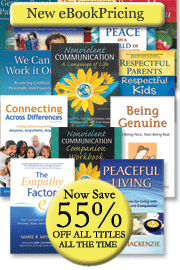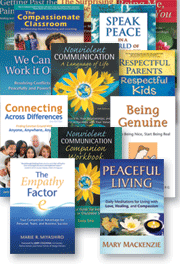Key Assumptions & Intentions... continued
Following are key assumptions that NVC practice is based on. Many traditions share these assumptions; NVC gives us concrete, powerful tools for putting them into practice. When we live based on these assumptions, self-connection and connection with others become increasingly possible and easy.
-
All human beings share the same needs: We all have the same needs, although the strategies we use to meet these needs may differ. Conflict occurs at the level of strategies, not at the level of needs.
-
Our world offers sufficient resources for meeting everyone's basic needs: The scarcity experienced by so many people arises because we have not designed our social structures to meet everyone's needs. We can attribute any apparent scarcity to a current systemic limitation, a crisis of imagination, or a lack of skills for fostering connection.
-
All actions are attempts to meet needs: Our desire to meet needs, whether conscious or unconscious, underlies every action we take. We only resort to violence or other actions that do not meet our own or others' needs when we do not recognize more effective strategies for meeting needs.
-
Feelings point to needs being met or unmet: Feelings may be triggered but not caused by others. Our feelings arise directly out of our experience of whether our needs seem to us met or unmet in a given circumstance. Our assessment of whether or not our needs are met almost invariably involves an interpretation or belief. When our needs are met, we may feel happy, satisfied, peaceful, etc. When our needs are not met, we may feel sad, scared, frustrated, etc.
-
All human beings have the capacity for compassion: We have an innate capacity for compassion, though not always the knowledge of how to access it. When we are met with compassion and respect for our autonomy, we tend to have more access to our own compassion for ourselves and for others. Growing compassion contributes directly to our capacity to meet needs peacefully.
-
Human beings enjoy giving: We inherently enjoy contributing to others when we have connected with our own and others' needs and can experience our giving as coming from choice.
-
Human beings meet needs through interdependent relationships: We meet many of our needs through our relationships with other people and with nature, though some needs are met principally through the quality of our relationship with ourselves and for some, with a spiritual dimension to life. When others' needs are not met, some needs of our own also remain unmet.
-
Human beings change: By virtue of the constantly unfolding nature of needs and strategies to meet them, all of us are dynamic processes, not static entities.
-
Choice is internal: Regardless of the circumstances, we can meet our need for autonomy by making conscious choices based on awareness of needs.
-
The most direct path to peace is through self-connection: Our capacity for peace is not dependent on having our needs met. Even when many needs are unmet, meeting our need for self-connection can be sufficient for inner peace.
We hold the following intentions when using NVC because we believe that they help us contribute to a world where everyone's needs are attended to peacefully.
-
Self-compassion: We aim to release all self-blame, self-judgments, and self-demands, and meet ourselves with compassion and understanding for the needs we try to meet through all our actions.
-
Expressing from the heart: When expressing ourselves, we aim to speak from the heart, expressing our feelings and needs, and making specific, do-able requests.
-
Receiving with compassion: When we hear others, we aim to hear the feelings and needs behind their expressions and actions, regardless of how they express themselves, even if their expression or actions do not meet our needs (e.g. judgments, demands, physical violence).
-
Prioritizing connection: We aim to focus on connecting open-heartedly with everyone's needs instead of seeking immediate and potentially compromised solutions, especially in challenging situations.
-
Beyond "right" and "wrong": We aim to transform our habit of making "right" and "wrong" assessments (moralistic judgments), and to focus instead on whether or not human needs appear met (need-based assessments).
-
Taking responsibility for our feelings: We aim to connect our feelings to our own needs, recognizing that others do not have the power to make us feel anything. This recognition empowers us to take action to meet our needs instead of waiting for others to change.
-
Taking responsibility for our actions: We aim to recognize our choice in each moment, and take actions that we believe will most likely meet our needs. We aim to avoid taking actions motivated by fear, guilt, shame, desire for reward, or ideas of duty or obligation.
-
Living in peace with unmet needs: We aim to work with our feelings when we experience our needs as unmet, connecting with the needs rather than insisting on meeting them.
-
Increasing capacity for meeting needs: We aim to develop our internal resources, particularly our NVC skills, so we can contribute to more connection and greater diversity of strategies for meeting needs.
-
Increasing capacity for meeting the present moment: We aim to develop our capacity to connect in each moment with our own and others' needs, and to respond to present stimuli in the moment instead of through static stories about who we and others are.
-
Caring equally for everyone's needs: We aim to make requests and not demands, thus staying open to the other's strategies to meet their needs. When hearing a "No" to our request, or when saying "No" to another's request, we aim to work towards solutions that meet everyone's needs, not just our own, and not just the other person's.
-
Protective use of force: We aim to use the minimum force necessary in order to protect, not to educate, punish, or get what we want without the other's agreement, and only in situations where we find that dialogue fails to meet an immediate need for physical safety. We aim to return to dialogue as soon as we have re-established a sense of physical safety.
Read articles by our own BayNVC staff. Also see other articles about Nonviolent Communication by Marshall Rosenberg and others.
by BayNVC Trainers
Basic information to support your learning and practice of compassionate communication.
by Inbal Kashtan of BayNVC.
by Miki Kashtan of BayNVC.
videos about BayNVC, and featuring BayNVC trainers
from the first season of our TV show
Inbal Kashtan has been passionate about the contribution NVC can make to creating a world where everyone matters and people have the skills for making peace since the mid-90’s. She focused primarily on leadership development and transforming parenting, as two powerful strategies for contributing to structural change. Some of her key NVC endeavors include co-founding Bay Area Nonviolent Communication (BayNVC) and the Leadership Program in 2002, creating the Peaceful Families, Peaceful World Project and the Parent Peer Leadership Program as joint CNVC/BayNVC projects, writing a dozen published articles and a booklet (Parenting From Your Heart) and creating a CD for parents (Connected Parenting).
Miki Kashtan is a co-founder of BayNVC. She is inspired by the role of visionary leadership in shaping a livable future, and works toward that vision by sharing the principles and practices of Nonviolent Communication through mediation, meeting facilitation, consulting, retreats, and training for organizations and committed individuals. She has taught NVC in many countries. Miki blogs at The Fearless Heart and her articles have appeared in Tikkun magazine, Waging Nonviolence, Shareable, and elsewhere. She holds a Ph.D. in Sociology from UC Berkeley.
Keep learning these vital
communication skills with these books and training
resources:
This Month's Specials:
- All eProduct Prices Reduced - Save 55% on all of our eProduct titles all the time.
- Reference Library Book Package or eBook Package - Save 65% off list price through March 31, 2013
Every Day Book
Package Specials:
- NVC Starter Kit Book Package and eBook Package - Save 40%-50% on this book package every day from PuddleDancer Press
- NVC Marshall B. Rosenberg, Ph.D. Book Package and eBook Package - Save 45%-55% on this book package every day from PuddleDancer Press
|
|


There are two things that distinguish truly nonviolent actions from violent actions.
First, there is no enemy in the nonviolent point of view. You don't see an enemy. Your thinking is clearly focused on protecting your needs.
Second, your intention is
not to make the other side suffer.
|






